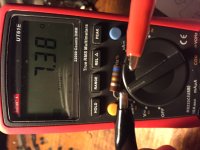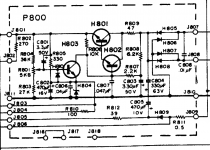🙂 OK
(I'm still very very surprised. Your meter reads essentially 0.00 when probes shorted. Resistor legs clean ? Not that I doubt you 😛)
(I'm still very very surprised. Your meter reads essentially 0.00 when probes shorted. Resistor legs clean ? Not that I doubt you 😛)
Yes, because I installed new resistors, that I matched in 4's 🙂 You do realise that I'd know if my meter is off. It's not the brightest (Uni-T UT61E), but it measured correctly all of my 1% metal films, all in spec. So when I read a carbon that is way off, I tend to trust it. More so, there were two resistors and both were off, one at about 8.2 and the other at 7.5 or something. The new ones are at 6.8 thou...
I'm just surprised that all 🙂 The 'shiny' glazed resistors used in older gear used to be pretty decent in my experience. The carbon composition type are the ones that do fail.
If they were out of tolerance I believe you. Honest 😀
If they were out of tolerance I believe you. Honest 😀
Silver is 10%.
So 6R8 10% is 6R12 to 7R5
It is in tolerance!
Plus did you null the probes with a zero ohm link? If not you can add 0.2 to 0.5R
It is very difficult to measure <10 ohms with any accuracy without a 4 wire connection.
So 6R8 10% is 6R12 to 7R5
It is in tolerance!
Plus did you null the probes with a zero ohm link? If not you can add 0.2 to 0.5R
It is very difficult to measure <10 ohms with any accuracy without a 4 wire connection.
I have others that measure fine <10 ohms. I know it is in spec, this is not the discussion. The thing is that it's at the outer limit, and I do have 6.8 ohm resistors 🙂
For me, it makes more sense to replace them with 1% matched (considering my meter is way off, 1% insures they are in spec and my dmm is used for matching duties). It just makes me feel better, even if Marantz chose 10% loosely.
Think of it this way, given the age of the resistor, and heat it's been subjected to, and the fact that carbon resistors are noisy, why wouldn't it make sense to replace them?
For me, it makes more sense to replace them with 1% matched (considering my meter is way off, 1% insures they are in spec and my dmm is used for matching duties). It just makes me feel better, even if Marantz chose 10% loosely.
Think of it this way, given the age of the resistor, and heat it's been subjected to, and the fact that carbon resistors are noisy, why wouldn't it make sense to replace them?
Silver is 10%.
So 6R8 10% is 6R12 to 7R5
It is in tolerance!
Plus did you null the probes with a zero ohm link? If not you can add 0.2 to 0.5R
It is very difficult to measure <10 ohms with any accuracy without a 4 wire connection.
8.2 or 8.4 ohms, the value of one resistor from the other board was not in tolerance. And this is one example, I found some more on the other boards. And I only tested randomly... I say it's good practice to replace all resistors.
Sure, if you'd repair or recap one for a client, maybe it's not worth the hassle. You know, he'll come back if anything's wrong 🙂 And maybe the cost of the work of replacing those wouldn't justify it, for both the client and technician. But for something that I am very fond of, yes ... it's worth replacing the crusty old (some) out of spec noisy carbon resistors for the cheapest 1% metal film 🙂 And while doing that, I get also to match them, 4 by 4 as there are 4 channels.
That is all fine if it makes you feel happy! No contest.
BUT, any thought that at limit, resistors and transistors will affect the sound, or even stop it working is heading for a disappointment.
It follows that after putting it all back together and playing music, you would have to be super-humanly objective in not declaring that "it sounds better!" 😀
BUT, any thought that at limit, resistors and transistors will affect the sound, or even stop it working is heading for a disappointment.
It follows that after putting it all back together and playing music, you would have to be super-humanly objective in not declaring that "it sounds better!" 😀
I don't know if you read what I wrote earlier. I declared that I'm not doing this for "improved SQ". I said I'm doing it as a refresh, up to date restore. I just want to feel relaxed knowing that there's decent quality, newer parts, that haven't been stressed in heat. I'm doing it from a technical point of view, not subjective SQ.
Yes, near the limit music doesn't stop coming out. Hell, it'll go a bit further and sound ok.
I don't know if all of a sudden I would have decided to go a replace all resistors in a Marantz 4230 amp. That's a bit crazy to be honest. But I saw that for a recap I need to pull all the boards out. So then it followed naturally 🙂
Yes, near the limit music doesn't stop coming out. Hell, it'll go a bit further and sound ok.
I don't know if all of a sudden I would have decided to go a replace all resistors in a Marantz 4230 amp. That's a bit crazy to be honest. But I saw that for a recap I need to pull all the boards out. So then it followed naturally 🙂
Here's one from the other board
That is a carbon composition type. All the 'shiny' glazed ones are different and will all be good.
I installed back in the original 2SC1384/2SA684 pairs.
Can anyone tell me if I can up the capacitors on the power supply?
Can anyone tell me if I can up the capacitors on the power supply?
Last edited:
Many will say yes you can. You can go up a little yes but I wouldn't go over the top. Increasing the value means the rectifiers conduct for a shorter time (because the cap holds more energy as it discharges between cycles), however they conduct 'harder' drawing more current over that shorter time. That can in extreme cases cause transformer saturation (a little unlikely here) causing the transformer to run hotter and maybe be noisier. It can also increase any volt drops caused by the cap charging currents. With perfect layout and a perfect grounding scheme on the PCB's that is no problem. If its less than perfect then you could actually hear an increase in residual 'hum' on the speaker feed.
Do not change any other capacitor values other than filter after rectifier as it will lead to unwanted clicks and pops from the amp.
Gajanan Phadte
Gajanan Phadte
C802 is a brute force large value cap across the zener reference for the error amplifier of the regulator.
I'm with gmphadte on this. Leave the original values. Why do you think they are unbalanced with a 470uf and a 330uf ? (C804 and 805)
I'm with gmphadte on this. Leave the original values. Why do you think they are unbalanced with a 470uf and a 330uf ? (C804 and 805)
C805 is for a rail that only goes to a tape monitor switch or something. So really only C803/C804 are filtering.
What is the purpose of C802? It has a ceramic bypass as well.
What is the purpose of C802? It has a ceramic bypass as well.
- Status
- Not open for further replies.
- Home
- Amplifiers
- Solid State
- to92 transistor replacement

